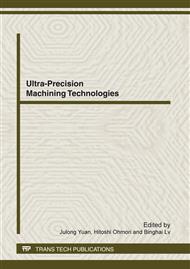p.56
p.61
p.68
p.73
p.78
p.83
p.89
p.94
p.99
Influence of Diameter and Number of Orifice on Static Characteristics of Radial-Thrust Aerostatic Bearing
Abstract:
The working performance of the spindle system is the most important factor to embody the overall performance of the machine tool. To ensure the advanced capabilities, besides the high-precision manufacturing technologies, it is mainly depending on the bearing module and the forces on the spindle. In this paper, a new strategy of the vertical spindle supporting system is presented to meet the high stiffness requirement for the aerostatic bearing. Based on the computational fluid dynamics and finite volume method, a fluid dynamic model and structure model of the large diameter incorporate radial-thrust aerostatic bearing is developed and simulated to find out the pressure distribution laws of the spindle supporting system. The grid subdivision in the direction of film thickness is paid more attentions when establishing the grid of the whole gas film. Simulation results show that this special structure of bearing module can supply enough load capacity and stiffness for the machine tool. The results also indicate that the static characteristics of the bearing are improved as the supply pressure increases and as the supply orifice diameter decreases.
Info:
Periodical:
Pages:
78-82
Citation:
Online since:
April 2012
Authors:
Price:
Сopyright:
© 2012 Trans Tech Publications Ltd. All Rights Reserved
Share:
Citation:


